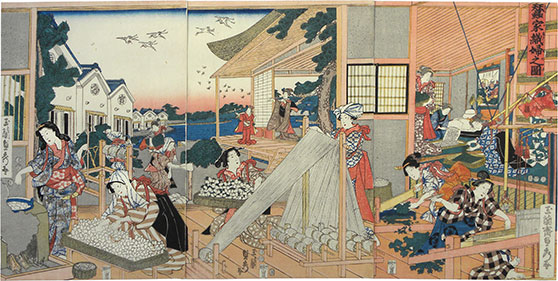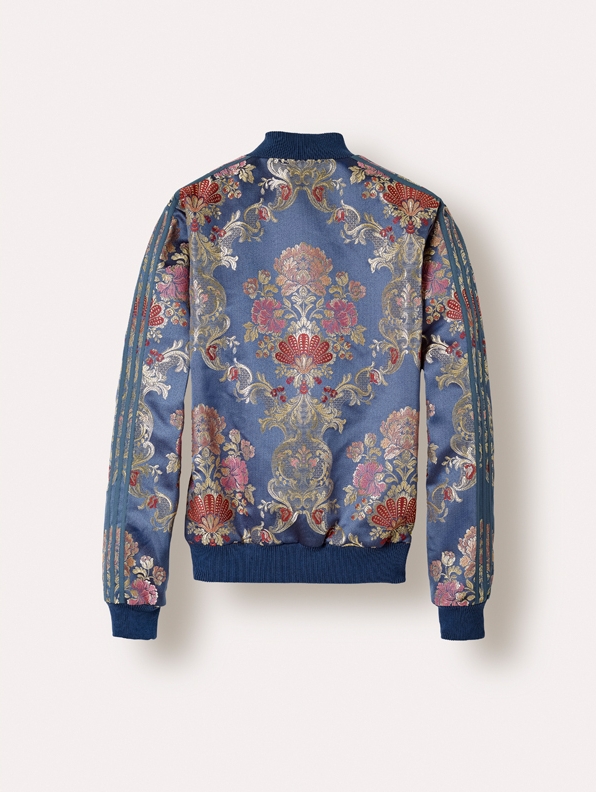Styling a Yogi: Jacquard and Silk

Paul Binnie, Scottish, b. 1967
This season I've been into the "silk trend" for sure. It's really adds good detail and sophistication to a rather average pair of denim jeans or trousers. One thing that I love about the look of this fabric is that it's so comfortable and you can wear it as an accessory because of the glow it gives. Jacquard on the hand is a print that I have grown fond of and I think it's definitely a winter trend. It's seen in fashion around the world and can be woven into detailed figures such as birds or floral images. With jacquard, I like seeing the two tone designs, it starts to look really creative. With silk, I'm really very into silver and pink right now. Funny thing is, as a person of color, I've always been told to stick to coppers and browns and dark/nude tones. But I think that anyone can really pull off their favorite colors. We should go beyond what "fits for a particular skin tone". I'm here to explore my own beauty and part of doing that is letting go of the social construct we live in. I've started learning about therapeutic colors and have become less shy about exploring a wider palette.

Utagawa Sadahide, 1807-1873 (weaving women at silk-making cottage)
Kimono (Furisode) Date: 20th century Culture: Japanese Medium: silk
Silk was once meant for the wealthy. Silk has been around for ages. In fact, the Silk Road was an ancient trade route used by merchants, soldiers, and people of all backgrounds during the Han Dynasty. I think it's kind of a beautiful thing that a piece of fabric could open so many doors economically and link together so many cultures. But it was not the only good making its way throughout Europe, Africa, India and China. Teas, metals, fur, spices, ivory, glass, aromatics, and precious stones traveled throughout this vast space and along the Mediterranean Sea and Indian Ocean. The free flowing ideas of philosophy, music, religion, technology, and art created prosperity and made it's historic mark along this route. Silk meant luxury. Sumptuary laws regulated the way in which society could dress. Many groups flourished, cultures intermixed, royalty was established. It was early globalization, the first exchange, like the internet we use today.

Jacquard print is a bit different because of the style of weaving used to make it. Jacquard material became known around 1801, during the Industrial Revolution. Joseph-Marie Charles Jacquard invented this pattern on a special power loom. It could weave a design based on a punched wooden card. This invention put a lot of loom operators out of work. When he displayed his invention at an exhibition in Paris, Joseph-Marie was asked in 1803 to work for the Conservatoire national des arts et métiers (National Conservatory for Arts and Crafts). Oddly enough, Jacquard's invention was strongly opposed by many silk-weavers! They feared this new technology because they felt it would take away from their labor. The loom itself caused an uproar of riots in the 18th century. Even today, people are still being replaced by machines and technology, history repeats itself! Adidas Originals + Pharell Williams created this unisex Jacquard Collection in 2015.
After I started seeing silk and satin everywhere, I became curious to learn about how it's is made. I made calls to various fabric production companies and fabric boutiques and learned that silk is not produced here in the Dallas area. I then found a group called, DFW Fiber Fest, a non-profit that supports the knitting, crocheting, and spinning craft. I spoke to a member who led me to Michael Cook. He's a local silkworm enthusiast. He knows how to rear silkworms and turn their cocoons into thread through silk reeling. His original heirloom machines from Japan are traditionally used in the silk-making process.

Shibori Hikizuri 1920s Ѯ Maiko (Apprentice Geisha) wearing a beautiful Shibori
"The machine is called a zakuri. The ones I have are antiques; I'm guessing probably around 80 to 100 years old. This is not the way they do things now, outside of special handcraft conservation - most silk now is made in factories in China, India, Africa, and South America." Japan has only small remnants of silk culture, in the same way that there are still Americans who spin with spinning wheels and raise their own cotton. The Japanese Empire was able to build much of their wealth on silk which catapulted them into the Industrial Period. Most people used zakuris at home and would grow the silkworms in their attics. Specialized Japanese fabrics were hand woven and used to design highly valued kimonos as part of the cultural tradition. The tradition honors and respects the hand-crafted fabric. "The bombyx mori silkworm is a domesticated animal, so it does not exist in the wild. There is currently not extinction issue, but there are some heritage breeds that are not as common. The silkworm is globally secure as a domesticated animal."
Another way people can achieve the silk look is by using satin. It can be made of polyester, rayon, silk or acetate. Satin is synthetic and technically a structure of thread that floats over multiple warp threads in the loom which creates a shiny look. Satin is what I typically wear. On the other hand, ahimsa silk has also been largely produced in the U.S. Ahimsa (or peace) is a Jain philosophy of non-violence and respect towards all living beings. It is a principle that is invoked in the Buddhist belief as well. Ahimsa silk is not as harmful to cocoons because they let the caterpillar hatch and emerge as moths, rather than cutting out the moth itself. This debate between both methods has caused some controversy due to vegetarianism reasons and the way silk is extracted from the cocoon. In fact, some Buddhists in India will wear only peace silk, made from such hatched cocoons. I was able to read about this process from Aurora Silk. In my opinion, after learning about silk-making, I've found a new appreciation for the ancient practice but would like to explore the idea of using ahimsa. I like having more choices as a consumer and would like to continue learning about the way products are made.
Jumpsuit: ASOS







Top: Missguided







Top: Verge Girl (similar), Skirt: Missguided












Top: Missguided















